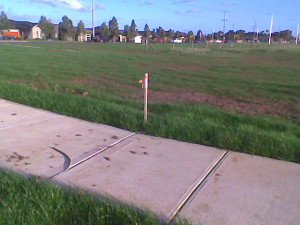Block Boundary Pegs
 Your block location is defined by its boundary pegs.
Your block location is defined by its boundary pegs.
It all looks quite simple when you are looking to buy the block. You can go out to the site and see tall pegs with tape at every corner.
A few months later when the builder is looking to start it can all be very different.
The pegs may have been stolen, or damaged, and your builder will be asking for $800 or more to re-establish the site boundaries.
Here is how you might save that money………………….
The first thing to understand is the tall pegs are indication markers, the actual boundary peg is normally driven down to just above ground level. (See photo below)
While the pegs are still obvious
-
- Take measurements so you can find or relocate the pegs accurately, this involves taking measurements to each peg from at least two points that are unlikely to be damaged. Examples are joints in concrete paths, drain covers, existing fences.
- Where possible you can use paint to mark concrete paths or fences.
- Make sure the boundary peg is knocked down to ground level.
- Cover the peg with gravel or sand so it looks different to the surrounding soil.
- You should now be able to find the boundary pegs, even if the marker pegs go missing.
- Don’t worry if one peg goes missing the builder only needs three pegs to do their set out.
If you want more information its worth reading the post on Reading Title Plans
